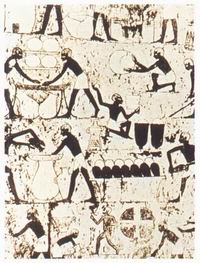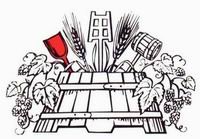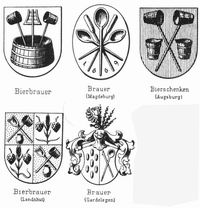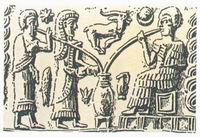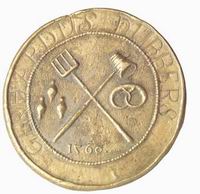Historical depictions, guild signs and symbols of the brewing and malting handcraft
Historical background
Before looking at the various depictions of brewers in the middle
ages, the history of the cultural beverage beer and the general situation of
humans in this era needs to be analysed.
2.1 Overview brewing history
Research in the field of food history and therefore also the history of beer are by no means complete today. Hence many details are yet to be agree on by the scientific community, as for instance where and when beer was first brewed and drunk by humans. For this question alone, many contradictory answers can be found in literature. This short abstract will therefore concentrate on the today firm facts of research.
It is undisputed that Sumerians and Egyptians as well as the
high cultures in the Yangtze valley (today's China) made beer or at least beer
like beverages. Precondition for this ability are settledness and knowledge
how to cultivate grain. Today research has shown, that these circumstances were
fulfilled in some areas of the world around 7000 B.C. We know from the Sumerians
and Babylonians, that they brewed up to 20 different types of beer. The code
of Hammurabi from 1728 B.C. contains some rules on beer tapping and beer quality
- if you will, the oldest purity law of the world
[7]
. Egyptian hyroglyphs describe the then common
brewing technique with the usage of beer bread, which was fermented spontaniously
- the yeast came from the air
[8]
.
The relation between bakers and brewers, which lasted until the middle ages and was expressed in many guilds [9] , can be explained through this historical technique.
Although they mainly were wine drinkers, the Greek adapted the "barley wine" from the Egyptians. The term "Zythos" or "Zythus" can be found in the works of many greek and roman writers, such as Plinius or Herodot. Tacitus speaks of a beer like beverage of the German tribes in his famed "De origine et situ Germanorum", written by the end of the first century [10] .
While quite unimportant in the Roman Empire, beer culture was continued and improved from the 6th century on by the monks of the christian monasteries in Europe. Even a beer tax had been introduced [11] . Hops, probably already know to the Egyptians, was rediscovered and made prelonged stability of beer possible, which enabled the trade with beer over longer distances. Traders of flourishing cities transported it from the 10th century onwards through the whole then known world. The nascent art of that time gave us the - as far as we know - oldest depiction of brewers.
In the middle ages the "Hanse", a city and trade union in northern Germany, shipped beer from Bremen and Hamburg throughout Europe. Despite those long transport ways, beer quality wasn't as perfect as today. The biochemical details of fermenting and beer stability weren't discovered until the 19th century. Sour tasting (hence infected) beer was assumed to be caused by evil magic or bad demons, fermentation was supposed to be god's influence.
The decline of the cities and hence the "Hanse" in the course of the 30 year war (1618-1648) caused a shift of beer competence towards the south of Germany, mainly Bavaria, as the purity law of 1516 had set standards for beer quality not only in big settlements (many cities had had purity laws before that time, however these were never mandatory for brewers outside the cities!) [12] . Technology wise, the English were the leading country in that era. Through the invention of the steam engine by James Watt and the following industrialization in the 17th and 18th century, they started a whole new epoch in brewing. The nascent chemistry was no less important. Not because of the development of additives or preserving agents (which weren't allowed in Germany anyways), but by creating the means for analysing the composition of beer, both production methods and quality of beer were increased considerably up until today.
2.1.1 Excursus: Historical malting technique
Modern breweries, especially the larger ones, seldomly produce their own malt and actually buy this essential raw material bought from commercial malt houses. This had not always been the case: The apprenticeship of todays brewing schools (at least the ones in Germany) is called "brewer and maltster" and that shows, that both handcrafts used to be united. This can been seen in the symbol of the brewing and malting craft, too:
Abb. 2: Zunftsymbol der Brauer und Mälzer,
in Kunze: Technologie der Brauer und
Mälzer
Next to the beer tumbler and the mahs fork one can see the malt scoop (marked red), and in addition hops and barley. In Munich for instance, the brewers prepared malt for the citizens, so that they could exert their home brewing right. [13] .
Nonetheless malt trading was common even then. Apparently it went so well, that the city council of Nuremberg felt compelled to stop the import of malt into the city alltogether: Ez ist auch gesetz, daz man kein malz in die stat furen sol [14] . There were also conflicts between brewers and mere maltsters, as the former wanted to have the malting right exclusivly for themselves [15] . In Landshut for instance the brewers convinced the city council to only grant them the malting right [16] .
So why were there at all maltsters, when brewers were malting themselves? To answer to this question lies in the home brewing right granted by Emperor Karl IV to every citizen [17] . Both monasteries and farmers sold not only grain, but also malted grain as this would achieve higher prices and malting was impossible in the small houses of the citizens. The clerus profited considerably from this malt trading, as they could produce without having to pay wages. To protect their own tax interests, the cities often tried to limit the monks in this trade, sometimes even with the help of the pope [18] .
Different then from today the brewers were not allowed to mill their malt themselves, and for tax reasons had to go to city controlled malt millers [19] . Hence beer was taxed twice: First a malt tax and then a beer or tapping tax.
Not everywhere the brewers malted themselves: In some cities of the middle ages, for instance in Freiberg [20] , Krakau [21] and Straubing [22] , the brewing and malting guild were separate. In Freiberg there even was a detailed listing of breweries and malthouses: In the 14th and 15th century 8 malthouses and 2 breweries [23] . Image 3 shows some brewing emblems, some with and some without malt scoop.
Historical pictures and images of plain maltsters were unfortunately not found in the course of research for this thesis. The depiction of Hans Osterstückh (image 12) bears the explicit term "brewer and maltster" [24] .
2.2 Types of beer in the middle ages
As described in the previous chapter, the cultural beverage beer has been a part of humanity for millenia. However, the barley drink of old times was quite different, from what we percieve as beer today. As seen in image 4 the Sumerians and Babylonians were drinking with straws, as the spelt and other leftovers from the grain would settle at the bottom of the fluid [25] .
The middle ages were in regards to brewing technologie closer to todays beer. Nürnberg guild laws states, that Man schol auch kein ander chorn preuwen denne gersten alein, weder haber noch chorn noch dinkel noch waitze [26] . (thou shalt not use any other grain for brewing than barley, wheat or spelt)
Abb. 4: Biertrinker in babylonischer Zeit,
in "Heute back ich ..", S. 44
Puchner und Muck point
out, that in Nürnberg bottom fermented beers were predominant
[27]
. Here the middle age beer drinker distinguishes
between red beer, white beer and wheat beer. The first refers to todays dark
beers, due to the then common use of smoke kilns most likely similar to nowadays
smokebeer from Bamberg
[28]
. White beer corresponds with today "Helles"
(not bavarian "Weißbier", which is a wheat). Last the wheat
beer, most likely coming from the Netherlands, was similar to todays "Weißbier"
(white beer) in Bavaria. The brewers were not free in their decision what beer
to make, as the city council determined exactly one type of beer for one brewer
[29]
.
2.3 Sociel structure in the middle ages
The present is dominated by catchwords like globalisation, individuality and pressure to perform. Many aspects of our lifes, such as health care or retirement are controlled and regimented by the state. Humanistic ideals are the basis of modern (western) societies. Different than in the Roman Empire however, these are valid for all members of a nation, at least on paper. Looking back at history one must realize, that this has not always been so.
After the decline of the Roman Empire and the following time of migration there was a "dark epoch" in Europe - the dark ages. Life in that ear was hard and full of suffering, a constant fight for survival. Cities with markets, mostly founded by Romans, were scarce on the territory of todays Germany. The majority of the population was working on the land of the lord or monastery and had to give up the 10th of every as corvee, a relict of antique slavery. Trade was limited (compared to roman times) due to the lack of common currency and markets, and specialisation had pretty much vanished. Farmers where largely self sufficent (at a low level) and therefore baking and brewing were common practice in the household, mostly done by women - the dower quite often included a brewing kettle [30] .
As the quality of drinking water quite often was low - bacteria infestations were common - beer as boiled and hence clean food had a high value. The brew itself was quite different from today, though not completly bequeathed, the list of ingredients included anything available in those days. In every day life of the farmes pragmatism was essential: At least there was something to drink and eat. The monasteries, cultural hot spots of that era, the economical situation was better. Basic division of labor was common and hence a specialisation in certain crafts. Combined with the ability to read and write the clerus was hence enabled to lay the scientific foundation of handcraft.
The first two centuries of the last millenia are characterized
by an enourmous amount of new city foundations. In Germany alone more than 3000
new settlements were founded, mostly close to castles. The sovereign granted
certain rights to the citizen, unthinkable for the commoners and farmers. As
a consequence, the cities grew rapidly, unfree people, that had lived for one
year and one day in a city became free, hence the proverb "Stadtluft macht
frei"
A deep recess occured through the Black Death in the 14th century, which killed nearly one quarter of Europe's population, and later through the 30 year war (1618-1648), which destroyed most german cities.
2.4
Formation of guilds
While everyday work used to be self sufficient for most farmers, in the new founded cities another principle was dominant: Division of labor. Basis were the newly founded markets and currencies, which enabled trading of merchandise [32] . The quickly growing cities had an great need of raw materials and goods of all kinds: Trade (in German: Handwerk i.e. handcraft) came into being.
As more and more humans surged into the cities, the various professions were rapidly overflown and hence the economic situation for the already established tradesmen worsened. As a consequence, they formed associations in order to protect their profession - in accordance with the city council - from newcomers. Those associations were called "trade guilds". One of the oldest were the weavers of Worms in 1106, but the brewers were also one of the first [33] .
The guilds controlled the technology of its members and set standards for quality and prices. [34] . In addition they supervised the training of the apprentices and took care of the eldery, who were unable to work anymore. The handiwork was not seldomly reglemented to every detail. Especially in all areas of food production, as brewing, precise rules were laid out. Detailed description on how to brew beer can be found in various chartes, i.e. Landshut, Munich, Regensburg and Nürnberg [35] . Main goal of the city councils was to ensure an adequate supply of inocuous food for the citizens. This aim was however only partially born out of charity: Unadequate supply quickly resulted in uprising, a horror scenario for any council. [36] .
Nürnberg was an exception: City council forbid the formation of guilds, as they seemd too independet: Ez schol auch kayn antwerc kayn aynunge under in machen ane des rates wort. Swer daz prichet, der gibt fiunf phunt [37] . In 1348 there even was a tradesmen revolt because of this, which was struck down one year later [38] . As the guilds in other cities, the council in Nürnberg told the master craftsmen how to do their job. The lack of guilds an the hence missing retirement system for tradesmen probably favored the formation of "Brüderstiftungen" (brother's endowments) [39] .
Depending on the size of the city and the rate of specialisation, the amount of guilds varied conserably. The brewers for instance were often combined with the bakers [40] . This technical relation had existed earlier before: In a blueprint of the monastery St. Gallen (Switzerland) from 820 bakery and malt house are side by side. The heat from the bakery was used for drying the malt [41] .
Abb. 5: Messingmedaille der Düsseldorfer Bäcker-
und Brauerzunft,
in "Heute back ich ..", S. 74
When guilds were combined, not always all emblems of the affected crafts were included. An interesting example can be found in Bamberg: On July 22nd 1684 prince-bishop Marquard Sebastian Schenk ruled, that the brewers and coopers (Büttner - barrel makers), as they had the same patron (Laurention, protector against fire), should be combined [42] . This can still be seen today, as the procession lances (used in catholic procession through the city) only show the emblem of the Büttner, the at that time more influencial craft.
In the following the depiction of brewers in the middle ages will be researched.
| previous chapter |
[7] Literaturverzeichnis: Wolfgang Kunze, S. 19
[8] Internetverzeichnis: A similar beverage exists today in Russia: Brot-Kwas, report of ZDF (2. German TV), also "Hexenküche" (see bibilography)
[9] Vgl. Kapitel 2.3 Entstehung der Zünfte
[10] Internetverzeichnis: Institut für Rechtsmedizin, Heinrich-Heine-Universität
[11] Literaturverzeichnis: Wilhelm Scheben, S. 35-37
[12] Internetverzeichnis: Media Aetas e.V.
[13] Literaturverzeichnis: Karin Hackel-Stehr, S. 19
[14] Literaturverzeichnis: Nürnberger Satzungsbücher, S. 57
[15] Literaturverzeichnis: Wilhelm Scheben, S. 20
[16] Literaturverzeichnis: Karin Hackel-Stehr, S. 84
[17] Literaturverzeichnis: Werner Schultheiß, S. 152, ebenso Hans Conrad Preyer, S. 15-16
[18] Literaturverzeichnis: Wilhelm Scheben, S. 22 f
[19] Literaturverzeichnis: Wilhelm Scheben, S. 25-26
[20] Literaturverzeichnis: Freiberger Altertumsverein, S. 85
[21] Literaturverzeichnis: Friedrich Winkler, S. 115
[22] Literaturverzeichnis: Karin Hackel-Stehr, S. 132
[23] Literaturverzeichnis: Freiberger Altertumsverein, S. 92
[24] Vgl. Kapitel 3.1: Hausbuch der Mendel
[25] Internetverzeichnis: Ph.D. Brian A. Nummer, ebenso Institut für Rechtsmedizin, Heinrich-Heine-Universität Düsseldorf
[26] Literaturverzeichnis: Nürnberger Satzungsbücher, S. 57
[27] Literaturverzeichnis: Puchner und Muck, S. 385
[28] Literaturverzeichnis: Werner Schultheiß, S. 13
[29]
Literaturverzeichnis: Werner Schultheiß ebenso
Nürnberger Satzungsbücher ebenso
Walter Grönert, Vgl. auch Kapitel 4: Ausschankzeichen
The image of the various beer type brewers was different: According to Emil
Reicke (S. 234) only red beer brewers were allowed to become members in the
city council.
[30] Literaturverzeichnis: Irene Krauß, S. 56
[31] Literaturverzeichnis: François Louis Ganshof, S. 397 ff
[32] Vgl. vorheriges Kapitel
[33] Literaturverzeichnis: Alfred Grenser, S. 1 f
[34] Literaturverzeichnis: Friedrich Winkler, S. 119 ff
[35] Literaturverzeichnis: Werner Schultheiß und Karin Hackel-Stehr
[36] Literaturverzeichnis: Hans Lentze, S. 244-245
[37] Literaturverzeichnis: Nürnberger Satzungsbücher, S. 58
[38] Literaturverzeichnis: Emil Reicke, S. 204 f
[39] Literaturverzeichnis: Mendelsche und Landauer Zwölfbrüderstiftung, siehe auch Kapitel 3
[40] Vgl. Kapitel 2.1: Übersicht über die Biergeschichte
[41] Literaturverzeichnis: Irene Krauß, S. 59
[42] Literaturverzeichnis: Werner Scharrer, S. 165-166
